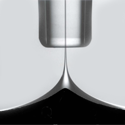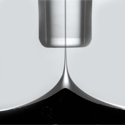Viscous pull
Shape transitions are ubiquitous in fluids. Consider for example what happens when a pipe is suspended just above the interface between two liquids. As the pipe begins to suction liquid from the top layer, the liquid flow will pull the interface between the two fluids upwards. As the flow rate through the pipe increases, this interface undergoes a shape transition from a gentle hump to a sharp neck at the point when the pipe starts to draw fluid from the lower liquid.
This type of necking effect can occur, for example, in microfluidic devices where fluids are channeled down extremely narrow passages or in the encapsulation of biological cells. But, researchers have not been able to capture the experimental details of the process with a simple scaling law that holds for different types of liquids and length scales. In a paper appearing in Physical Review Letters, François Blanchette and Wendy Zhang at the University of Chicago in the US treat this problem analytically and resolve the discrepancy between different experiments.
Blanchette and Zhang argue that the part that makes this problem hard to solve—the discontinuous neck that forms at the transition—is in fact, not important. Instead, they show that it is the gentle deflection of the interface far away from the opening of the tube that matters. With this simplifying assumption, they find a simple scaling relation between the critical flow rate at which the shape transition occurs and the height of the pipe above the interface and outline the experimental regimes where this law applies. – Jessica Thomas





